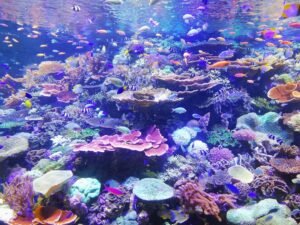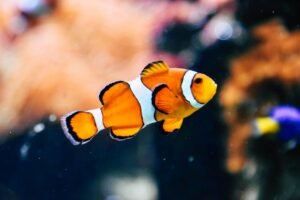Owning a fish tank can be a rewarding and fulfilling experience, but it also comes with its fair share of complexities. From choosing the right size and shape for your home to maintaining water quality and creating a natural environment for your fish, there are many factors to consider when designing and maintaining a fish tank. In this article, we will explore the various aspects of fish tank ownership and provide tips and advice to help you create a beautiful and healthy aquatic habitat for your fish.
Key Takeaways
- Choose a fish tank size and shape that fits your home and lifestyle.
- Select fish species that are compatible with your tank and each other.
- Create a natural aquatic environment with plants and decorations.
- Maintain water quality and filtration for healthy fish.
- Control lighting and temperature to promote fish health and growth.
Choosing the Right Fish Tank Size and Shape for Your Home
When it comes to selecting a fish tank, size and shape are important factors to consider. The size of your tank will depend on the number and size of fish you plan to keep, as well as the available space in your home. It’s important to choose a tank that is large enough to accommodate your fish comfortably, as overcrowding can lead to stress and poor water quality.
In terms of shape, there are several options available, including rectangular, square, round, and hexagonal tanks. Each shape has its own pros and cons. Rectangular tanks are the most common and provide the most surface area for oxygen exchange. Square tanks are also popular and offer a balanced aesthetic. Round tanks can be visually appealing but may have limited swimming space for fish. Hexagonal tanks offer a unique look but can be challenging to clean.
To find the perfect fit for your home, consider the available space, your personal preferences, and the needs of your fish. It’s also important to consider the weight of the tank when filled with water, as larger tanks can be quite heavy.
Tips for Selecting the Best Fish Species for Your Tank
Choosing the right fish species for your tank is crucial for creating a harmonious and balanced ecosystem. There are several factors to consider when selecting fish species, including their size, temperament, and compatibility with other species.
It’s important to choose fish that are suitable for the size of your tank. Some fish species require larger tanks with ample swimming space, while others can thrive in smaller tanks. Research the adult size of the fish you are interested in and make sure they will have enough room to grow and swim comfortably.
Compatibility between different fish species is also important to consider. Some fish are more aggressive and may not get along well with others. It’s important to choose fish that have similar temperaments and dietary needs to avoid conflicts and ensure a peaceful environment.
Finding the right balance of fish for your tank is also crucial. Overstocking your tank can lead to poor water quality and increased stress for your fish. It’s important to research the specific needs of each species and ensure that they can coexist harmoniously in your tank.
Creating a Natural Aquatic Environment with Plants and Decorations
| Metrics | Description |
|---|---|
| Water pH | The measure of acidity or alkalinity of the water. Ideal range for most aquatic plants is between 6.5 and 7.5. |
| Water hardness | The measure of dissolved minerals in the water. Ideal range for most aquatic plants is between 3 and 8 dGH. |
| Light intensity | The amount of light that reaches the plants. Different plants require different levels of light intensity. |
| CO2 levels | The amount of carbon dioxide in the water. Plants use CO2 for photosynthesis and growth. |
| Nutrient levels | The amount of nutrients in the water. Plants require nutrients such as nitrogen, phosphorus, and potassium for growth. |
| Plant species | The type of plants used in the aquarium. Different plants have different requirements and provide different benefits to the aquatic environment. |
| Decorations | The type and placement of decorations in the aquarium. Decorations provide hiding places for fish and can enhance the natural look of the aquarium. |
Creating a natural environment for your fish is not only aesthetically pleasing but also essential for their well-being. Adding live plants and decorations to your tank can provide hiding places, create territories, and improve water quality.
When selecting plants for your tank, consider their lighting and nutrient requirements. Some plants require high-intensity lighting and nutrient-rich substrates, while others can thrive in low-light conditions. It’s important to choose plants that are compatible with the lighting system in your tank and provide the necessary nutrients for their growth.
In terms of decorations, there are many options available, including rocks, driftwood, caves, and artificial structures. These decorations can provide hiding places for your fish and create territories within the tank. It’s important to choose decorations that are safe for your fish and won’t harm them or affect water quality.
When arranging your tank, consider the needs of your fish and create a layout that provides ample swimming space as well as hiding places. It’s important to create a natural and balanced environment that mimics the fish’s natural habitat.
Understanding the Importance of Water Quality and Filtration
Maintaining water quality is crucial for the health and well-being of your fish. Poor water quality can lead to stress, disease, and even death. There are several factors that can affect water quality, including ammonia, nitrite, nitrate levels, pH, and temperature.
To maintain water quality, it’s important to invest in a good filtration system. There are several types of filtration systems available, including mechanical, biological, and chemical filtration. Mechanical filtration removes debris and particles from the water, while biological filtration breaks down harmful substances such as ammonia and nitrite. Chemical filtration uses activated carbon or other media to remove impurities from the water.
It’s important to choose a filtration system that is appropriate for the size of your tank and the needs of your fish. Regular maintenance of the filter is also important to ensure its effectiveness.
In addition to filtration, regular water testing is important to monitor water parameters such as ammonia, nitrite, nitrate levels, pH, and temperature. It’s important to keep these parameters within the appropriate range for your fish species.
Lighting and Temperature: Essential Factors for a Healthy Fish Tank

Proper lighting and temperature are essential for the health and well-being of your fish. Lighting provides energy for plants and helps regulate the fish’s biological processes, while temperature affects their metabolism and overall health.
When it comes to lighting, it’s important to choose a system that provides the appropriate spectrum and intensity for your plants and fish. Some fish species require high-intensity lighting for their growth and coloration, while others can thrive in low-light conditions. It’s important to research the lighting requirements of your specific fish species and choose a lighting system accordingly.
Temperature is another important factor to consider. Different fish species have different temperature requirements, so it’s important to choose a heating system that can maintain the appropriate temperature range for your fish. It’s also important to monitor the temperature regularly and make adjustments as needed.
Maintaining the right balance of light and heat in your tank is crucial for the health and well-being of your fish. It’s important to provide a consistent and stable environment to minimize stress and promote optimal growth and health.
Adding Live Rock and Sand for a More Realistic Look
Adding live rock and sand to your tank can enhance its visual appeal and create a more realistic and natural environment for your fish. Live rock is typically made of calcium carbonate and provides a habitat for beneficial bacteria, which help break down waste and maintain water quality. Live sand, on the other hand, contains beneficial bacteria that help establish a healthy biological filter.
Live rock and sand can also provide hiding places for your fish and create territories within the tank. They can also help create a more natural-looking aquascape.
When adding live rock and sand to your tank, it’s important to choose high-quality products that are free of harmful substances. It’s also important to properly clean and cure the rock before adding it to your tank to remove any unwanted pests or toxins.
Enhancing Your Fish Tank with Custom Backgrounds and Themes
Customizing your fish tank with backgrounds and themes is a great way to showcase your personal style and create a unique and personalized design. There are many options available when it comes to backgrounds, including printed backgrounds, 3D backgrounds, and DIY backgrounds.
Printed backgrounds are easy to install and come in a variety of designs, including underwater scenes, coral reefs, and natural landscapes. 3D backgrounds provide a more realistic look and can be customized to fit the dimensions of your tank. DIY backgrounds allow you to create a custom design using materials such as foam, rocks, or driftwood.
When choosing a background, consider the overall theme or aesthetic you want to achieve. You can create a natural-looking tank with a coral reef theme or a more whimsical tank with a fantasy theme. The possibilities are endless, so let your creativity shine.
Maintaining Your Fish Tank: Cleaning, Feeding, and Water Changes
Regular maintenance is crucial for the health and well-being of your fish. Cleaning your tank regularly helps remove debris and waste, while feeding your fish a balanced diet ensures their nutritional needs are met. Performing regular water changes helps maintain water quality and removes accumulated toxins.
When cleaning your tank, it’s important to remove any uneaten food, debris, and waste. Use a siphon or gravel vacuum to clean the substrate and remove any excess waste. It’s also important to clean the glass or acrylic surfaces of the tank to remove algae and other buildup.
Feeding your fish a balanced diet is important for their overall health and well-being. Different fish species have different dietary requirements, so it’s important to research the specific needs of your fish and provide them with appropriate food. Overfeeding can lead to poor water quality and obesity, so it’s important to feed your fish in moderation.
Performing regular water changes is crucial for maintaining water quality. It helps remove accumulated toxins, replenish essential minerals, and maintain stable water parameters. The frequency and volume of water changes will depend on the size of your tank and the needs of your fish. It’s important to monitor water parameters regularly and make adjustments as needed.
Avoiding Common Mistakes in Fish Tank Design and Maintenance
When it comes to designing and maintaining a fish tank, there are several common mistakes that beginners often make. These mistakes can lead to poor water quality, stress for your fish, and even death. Here are some tips to help you avoid these common mistakes:
– Overstocking: Overstocking your tank can lead to poor water quality and increased stress for your fish. It’s important to research the specific needs of each fish species and ensure that they can coexist harmoniously in your tank. Avoid overcrowding and provide ample swimming space for your fish.
– Poor Filtration: Investing in a good filtration system is crucial for maintaining water quality. Make sure to choose a filtration system that is appropriate for the size of your tank and the needs of your fish. Regular maintenance of the filter is also important to ensure its effectiveness.
– Neglecting Water Changes: Regular water changes are crucial for maintaining water quality. Neglecting water changes can lead to a buildup of toxins and poor water quality. It’s important to perform regular water changes and monitor water parameters regularly.
– Overfeeding: Overfeeding can lead to poor water quality and obesity in your fish. It’s important to feed your fish in moderation and provide them with a balanced diet. Research the specific dietary needs of your fish species and adjust their feeding accordingly.
– Lack of Research: One of the biggest mistakes beginners make is not doing enough research before setting up their tank. It’s important to research the specific needs of your fish species, including their size, temperament, dietary requirements, and compatibility with other species. This will help you create a harmonious and balanced ecosystem.
Showcasing Your Fish Tank: Tips for Photography and Display
Once you have designed and maintained your fish tank, it’s time to showcase it in all its glory. Taking great photos of your tank can help capture its beauty and share it with others. Here are some tips for taking great photos of your tank:
– Lighting: Proper lighting is crucial for capturing the colors and details of your fish and plants. Make sure to use a high-quality camera with good low-light capabilities or invest in a lighting system that enhances the colors in your tank.
– Composition: Pay attention to the composition of your photos. Consider the rule of thirds and experiment with different angles and perspectives. Try to capture the natural behavior of your fish and create a sense of depth in your photos.
– Clean Glass: Make sure to clean the glass or acrylic surfaces of your tank before taking photos. Remove any algae or debris that may obstruct the view. Use a clean cloth or sponge to wipe the surfaces and avoid using any chemicals that may harm your fish.
– Patience: Taking great photos of your fish tank requires patience. Fish can be fast-moving and unpredictable, so it may take some time to capture the perfect shot. Be patient and take multiple photos to increase your chances of getting a great shot.
In addition to photography, displaying your tank in your home is also important. Consider the available space and choose a location that allows for easy viewing and maintenance. Make sure to provide adequate lighting and consider adding additional decorations or furniture to enhance the overall aesthetic.
The Art of Fish Tank Ownership
Owning a fish tank is not just about keeping fish; it’s an art form that requires careful consideration and attention to detail. From choosing the right size and shape for your home to maintaining water quality and creating a natural environment, there are many intricacies involved in fish tank ownership.
By following the tips and advice provided in this article, you can create a beautiful and healthy aquatic habitat for your fish. Take the time to research and understand the specific needs of your fish species, invest in high-quality equipment, and maintain regular maintenance routines.
Remember, owning a fish tank is not just a hobby; it’s a commitment to providing a safe and healthy environment for your fish. With proper care and attention, your fish tank can become a stunning centerpiece in your home and a source of joy and relaxation for years to come.
If you’re interested in fish tanks, you might also want to check out this fascinating article on the impact of natural disasters on aquatic life. In a recent earthquake that struck central Japan, the tremors caused significant damage to fish tanks and aquariums, leading to the loss of many precious marine species. The article explores the challenges faced by aquarium owners and the efforts taken to restore and protect these delicate ecosystems. It’s a compelling read that sheds light on the unexpected consequences of natural disasters. Read more here.




















+ There are no comments
Add yours